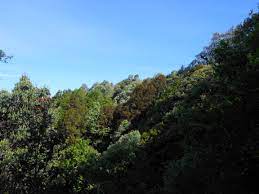
Binsar Wildlife Sanctuary

19.12.2023
Binsar Wildlife Sanctuary , Daily Current Affairs , RACE IAS : Best IAS Coaching in Lucknow
|
For Prelims:About Binsar Wildlife Sanctuary,History,Binsar Zero Point,Binsar Wildlife Sanctuary Flora and fauna,Binsar Mahadev Temple |
Why in the news?
Recently,In a remarkable discovery, a tiger was spotted in the high-altitude area of Binsar Wildlife Sanctuary,which is generally not considered a favourable habitat for tigers due to the cold climate.
About Binsar Wildlife Sanctuary
- It is located in the foothills of Himalayas in Almora district of Uttarakhand.
- The peak point known as Jhandi Dhar is at an elevation of 2412 meters.
- It is situated in the Kumaon Himalayas, at an altitude ranging from 900 to 2,480 meters (2,953 to 8,136 feet) above sea level.
- The sanctuary spans across an area of about 47 square kilometers and was established in 1988 with the purpose of conserving the diverse flora(the broad leaf oak forests, mainly located in the Central Himalayan region) and fauna of the region.
- Apart from protecting wildlife, the sanctuary was established with an aim to conserve Binsar as the summer capital of the Chand Kings, who ruled Kumaon from the 11th to 18th centuries.
- The sanctuary has been declared an Important Bird Area by Bird Life International as there are more than 200 species of birds in the sanctuary, including Fork tail, Blackbirds, Laughing Thrush, Pheasant, Nuthatches, Parakeets and Monal.
- One of the major attractions in the sanctuary is the Binsar Zero Point. It offers a panoramic 360-degree view of the snow-capped peaks of the Himalayas, including Nanda Devi, Trishul, Chaukhamba, Kedarnath, Shivling and Panchachuli. This viewpoint is a popular spot for nature lovers and photographers.
Binsar Wildlife Sanctuary History
- Ancient Settlements and Chand Dynasty: Binsar has a history of ancient human settlements, with evidence of human habitation in the area since ancient times.
- The Chand dynasty, which ruled over the Kumaon region from the 7th to 18th century AD, made Binsar their summer capital.
- Binsar served as an important center of power and administration for the Chand rulers.
- The Chand dynasty built temples and structures in the region, showcasing their cultural and architectural influence.
Binsar Zero Point
- Binsar Zero Point, also known as Binsar Viewpoint, is a popular attraction located within Binsar Wildlife Sanctuary in Uttarakhand, India.
- It offers breathtaking panoramic views of the surrounding Himalayan mountain ranges and is a must-visit destination for nature lovers and adventure enthusiasts.
- At Binsar Zero Point, visitors can witness the majestic snow-capped peaks of the Himalayas.
- On clear days, the views extend to prominent peaks like Nanda Devi, Trishul, Chaukhamba, Kedarnath, Shivling and Panchachuli, and many others.
- The viewpoint provides a unique vantage point to soak in the awe-inspiring beauty of the Himalayan range.
Binsar Mahadev Temple
- It is a revered Hindu temple located within the Binsar Wildlife Sanctuary in Uttarakhand, India.
- It is a 16th-century temple dedicated to Lord Shiva, one of the principal deities in Hinduism.
- The temple holds historical and religious significance and is a popular pilgrimage site for devotees and tourists alike.
- The Binsar Mahadev Temple is known for its serene and tranquil ambiance, nestled amidst the dense forests of Binsar Wildlife Sanctuary.
- It is believed to have been constructed during the reign of the Chand dynasty, which ruled over the Kumaon region.
- The temple's architecture reflects the traditional Kumaoni style, with intricate wood carvings and a simple yet elegant design.
Source:Hindustan times